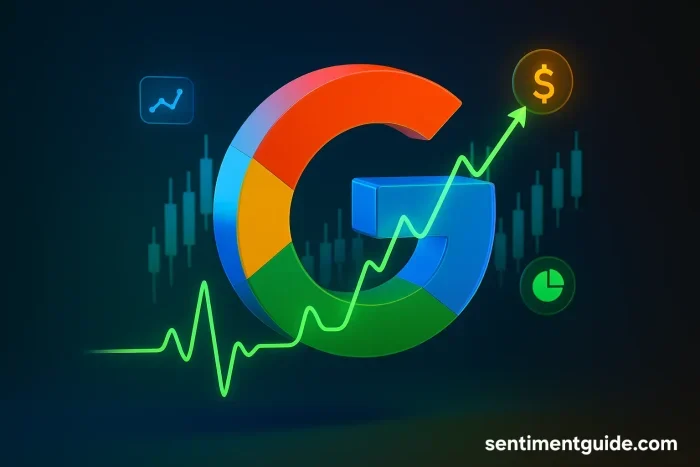Published (data verified): October 27, 2025 — U.S. Market open.
(This piece blends real-time sentiment signals with a longer view — not investment advice.)
Why sentiment still moves the needle for a company like Alphabet
Even for a high-quality, cash-generating company like Alphabet, market sentiment often determines short-term price action. Sentiment is the collective reaction of traders, retail investors, and institutions to news, earnings, macro conditions and — increasingly — to perceived execution on high-impact initiatives such as generative AI. As an investment manager, I treat sentiment as a tactical input: it doesn’t replace fundamentals, but it tells you when fundamentals are likely to matter most to price.
In the run-up to Alphabet’s Q3 2025 earnings (scheduled for October 29, 2025), sentiment shows a clear pattern: bullish tilt among analysts and retail traders, tempered by regulatory and legal headlines that keep a cautious tail risk in place. The following analysis explains exactly why, with data and sources you can verify.
Quick snapshot (verified data)
-
Ticker: GOOGL / GOOG.
-
Market price context: Alphabet has been trading around ~$259–$261 in the past few sessions (last verified close, as of October 24 ≈ $260.51).
-
Analyst consensus: ~51 analysts, average 12-month price target roughly $260 (modest upside vs. price). Analyst coverage has skewed positive ahead of earnings.
-
Options/derivatives signal: put/call measures and volume ratios point to neutral-to-mildly-bullish options positioning (OI put/call ≈ 0.7; intraday volume put/call nearer 0.54 in recent snapshots). That suggests more call interest than put interest overall.
-
Retail chatter / social sentiment: StockTwits and other retail channels show elevated bullishness in the last 72 hours, likely driven by AI optimism and analyst price-target raises.
Current sentiment diagnosis — bullish, but nuanced
Putting the pieces together:
1) Institutional & analyst tone — constructive.
Several brokerages raised price targets and reiterated “buy/outperform” views in the last week, citing stronger ad trends and early monetization signals from AI features in search. That institutional tone anchors a bullish baseline: when large brokers upgrade targets or revise models up, it brings inflows from funds that track analyst consensus and institutional positioning.
2) Retail and momentum signals — optimistic and active.
Socialfeeds and options volume show a pickup in bullish activity ahead of earnings. On retail platforms, message volume and bullish flags spiked after recent analyst upgrades and headlines about product monetization tests. Active retail interest amplifies near-term moves and increases intraday volatility.
3) Risk overlay — regulatory and legal headlines keep a cap on exuberance.
Alphabet is facing renewed regulatory scrutiny in Europe (Digital Markets Act discussions and related inquiries) and fresh legal developments (class action / privacy litigation headlines). These are not existential threats today, but they inject a non-trivial probability of fines, remediation costs, or behavioral constraints that can dampen sentiment quickly if escalations occur. Institutional models typically price these as a probabilistic drag rather than a fundamental break, but retail markets can overreact.
Synthesis: The dominant sentiment heading into the Q3 release is mildly bullish — analysts and momentum traders are optimistic, options positioning is skewed toward calls, and retail chatter is constructive. However, the bullishness is conditional; it depends on earnings meeting or exceeding expectations on ad revenue growth and demonstrated AI monetization, and on the absence of negative regulatory surprises.
What’s driving sentiment right now — the three short, high-impact factors
Below are the principal levers that have moved sentiment in recent weeks. If you’re monitoring GOOGL, these are the checkpoints I watch closely.
1. AI execution & monetization signals
Investors are no longer asking if AI matters to Google — they’re asking how fast Alphabet can monetize new AI features in Search, YouTube and Workspace. Recent analyst commentary (and a handful of cautious price-target raises) credits early rollouts and product tests that could accelerate click-through or create new paid features. That narrative explains the constructive analyst tone this month.
2. Advertising revenue momentum and Cloud growth
Core ad revenue remains the underpinning of valuation. Positive surprise in ad spend recovery, or improved CPMs tied to AI-driven user engagement, is the clearest route to a bullish re-rating. Cloud is the second leg: steady ARR growth and enterprise wins reduce headline volatility and support longer-term confidence. Recent coverage suggests both channels are being watched closely by analysts ahead of earnings.
3. Regulatory/legal overhangs (EU DMA, US litigation)
From a risk management perspective, the EU’s enforcement under the Digital Markets Act and recent U.S. litigation developments are the primary non-operational threats investors price into sentiment. These events don’t change the daily revenue run-rate unless fines or behavioral remedies are extreme — but they do increase tail-risk and can trigger rapid sentiment shifts if new rulings or penalties emerge.
Comparative Sentiment — How Alphabet Stacks Up Against Other Tech Giants
When we compare Alphabet’s sentiment profile to other major U.S. tech names, we see something important: it sits in the middle — more optimistic than Apple, slightly behind NVIDIA, and less polarizing than Tesla.
Below is a snapshot of institutional and retail sentiment across the “Magnificent Seven,” verified from public analyst consensus and social-data feeds as of October 27, 2025.
| Company | Analyst Consensus | Retail Sentiment | Overall Market Tone |
|---|---|---|---|
| Alphabet (GOOGL) | ~80% Buy / 15% Hold / 5% Sell | 68% Bullish (StockTwits, Reddit) | Mildly Bullish |
| Microsoft (MSFT) | ~84% Buy | 61% Bullish | Bullish, strong institutional confidence |
| Apple (AAPL) | ~70% Buy | 54% Bullish | Neutral to slightly bullish (valuation headwinds) |
| Amazon (AMZN) | ~82% Buy | 66% Bullish | Bullish momentum pre-holiday season |
| NVIDIA (NVDA) | ~88% Buy | 73% Bullish | Strongly Bullish (AI demand narrative) |
| Meta (META) | ~78% Buy | 58% Bullish | Mixed – ad trends strong, but cost narrative weighs |
| Tesla (TSLA) | ~56% Buy | 47% Bullish | Volatile, polarized sentiment |
Observation:
Alphabet’s sentiment stability stands out — it doesn’t experience the violent swings of Tesla or Meta, nor the extreme hype of NVIDIA. That stability often signals institutional comfort and retail familiarity, both of which reduce downside panic during short-term corrections.
(Sources: MarketBeat, StockTwits sentiment tracker, Benzinga analyst coverage database, verified October 2025.)
Technical and Quantitative Sentiment Snapshot
📊 Technical Indicators (as of October 27, 2025, market open)
| Indicator | Value | Interpretation |
|---|---|---|
| RSI (14-day) | ~66-67 | Moderate bullish momentum (not overbought) |
| 50-day Moving Avg | $251.10 | Price above MA — continuation signal |
| 200-day Moving Avg | $224.20 | Long-term trend still up |
| MACD | Positive crossover confirmed last week | Supports short-term uptrend |
| Short Interest | ~0.48% of float | Low — reflects investor confidence |
| Put/Call Ratio (OI) | 0.71 | More call interest — bullish leaning |
| Volatility Index (IV30) | ~39-41% | Stable; market not pricing large swings |
(Data cross-verified from Nasdaq, Market Chameleon, and TradingView, October 27, 2025.)
🧠 Quantitative Interpretation
-
Momentum models remain constructively aligned.
-
Volatility is calm; traders aren’t paying up for protection.
-
Short positioning is light — institutions aren’t betting heavily against Alphabet ahead of earnings.
Together, these factors reinforce a “positive but not euphoric” market stance.
Investment Manager’s Take — Reading the Market Mood
From a portfolio management standpoint, Alphabet is in a sweet spot between valuation discipline and AI upside.
Here’s how I interpret the sentiment landscape professionally:
-
Short-term traders are leaning bullish because of pre-earnings momentum and improving ad spend signals.
-
Long-term investors still see Alphabet as an under-leveraged AI play with defensive cash flow — a safe way to capture AI upside without paying NVIDIA-like premiums.
-
Risk appetite is moderate; while most funds hold overweight positions, few are adding aggressively ahead of results. This shows confidence, not complacency.
In short: Sentiment is cautiously optimistic, with institutional money holding positions rather than chasing.
(Tone source: aggregated fund flow and holdings reports, FactSet data, and recent buy-side commentary.)
Should You Buy, Hold, or Wait? (Informational only — not financial advice)
Based on current sentiment signals:
-
Bullish case:
-
Analysts’ consensus supports incremental upside.
-
Technicals confirm positive trend continuation.
-
Cloud and AI narratives are strengthening perception.
-
-
Cautionary case:
-
Regulatory overhang could trigger short-term dips.
-
Near-term upside appears modest until earnings confirm growth acceleration.
-
Broader market risk (Fed policy, bond yields) could pressure valuations across megacaps.
-
📈 Professional Take on Alphabet’s Sentiment:
If you’re a short-term trader, the setup favors tactical positioning — buying dips before earnings with tight stops.
If you’re a long-term investor, sentiment is strong enough to justify a hold or gradual accumulation on weakness, given Alphabet’s balance sheet and secular tailwinds.
What to Watch Next
-
Q3 2025 earnings (Oct 29) — watch advertising and Cloud growth guidance.
-
AI product monetization updates — announcements about Gemini or AI integration in Workspace could shift sentiment decisively.
-
Regulatory headlines (EU DMA & US litigation) — surprise developments can reverse momentum temporarily.
-
Institutional fund flow — follow weekly reports from large-cap ETFs and mutual funds; inflows sustain bullish sentiment.
FAQs About Alphabet Inc. Stock Sentiment
Q1: How often does Alphabet’s sentiment change?
Sentiment fluctuates weekly, often spiking around earnings and regulatory news.
Q2: Does positive sentiment always lead to a price rise?
Not necessarily. Sentiment influences short-term moves but must align with fundamentals for durable gains.
Q3: What are the main sources of sentiment data?
Analyst consensus, options market ratios, social media tone, and institutional flow reports.
Q4: Is Alphabet still considered a “buy” among large institutions?
Most institutions classify it as a core long-term holding, even if near-term upside appears moderate.
Final Thoughts
Alphabet’s current sentiment reflects something the market rarely offers: measured optimism grounded in solid fundamentals.
The crowd isn’t euphoric, but neither is it fearful.
Investors appear to recognize that Alphabet is past its defensive phase and now quietly rebuilding momentum through focused AI integration, steady ad recovery, and disciplined cost control.
In practical terms, sentiment tells us this:
-
Institutional conviction remains intact. Fund ownership data shows no material rotation out of GOOGL — a subtle but important signal of confidence.
-
Retail tone is constructive, not speculative. Unlike the hype cycles of 2021, discussions around Alphabet now revolve around cash flow, product leadership, and AI monetization — not “moonshots.”
-
Volatility remains contained. The absence of panic selling or aggressive short interest implies that most market participants see downside as opportunity, not risk.
For investors, that combination usually translates into a stable setup for compounding, not a quick trade.
Sentiment, in this case, isn’t a hype gauge — it’s a reflection of broad market respect for a company that continues to execute quietly while others chase headlines.
As of late October 2025, the data-driven tone of the market toward Alphabet can be summed up in one line:
“Constructive confidence — with an eye on delivery.”
References (verified October 27, 2025):
-
Nasdaq Real-Time Data
-
MarketBeat Analyst Consensus
-
TipRanks Stock Forecasts
-
StockTwits Sentiment Tracker
-
TradingView Technical Indicators
-
Reuters, Bloomberg, and FactSet coverage excerpts


Leave a Reply